In September 2020, we asked people in the region their opinions about our transportation system. The Voices of the Region survey is a part of the update to Visualize 2045. This public opinion survey will help planners and decisionmakers think about what kinds of improvement people in the region want for the transportation system in the future. We asked people about their thoughts on transportation since COVID-19, how they imagine they will use the system in the future, and their opinions about equity and climate change. In this third instalment of our series on the survey, we’re exploring what people in the region have to say about the TPB’s aspirational initiatives.
About the aspirational initiatives
In 2017, while developing Visualize 2045, the TPB looked at more than 80 projects, programs, and policies that are not currently funded, but could potentially address key challenges the region is facing. Some of these ideas were packaged into “initiatives” that were analyzed for their impacts on future transportation conditions. Based upon analysis and discussion, the TPB endorsed seven initiatives in early 2018 for future concerted action and inclusion in the aspirational element of Visualize 2045.
The seven initiatives are:
- Bring Jobs and Housing Closer Together
- Expand Bus Rapid Transit Regionwide
- Move More People on Metrorail
- Provide More Telecommuting and Other Options for Commuting
- Expand Express Highway Network
- Improve Walk and Bike Access to Transit
- Complete the National Capital Trail Network
Learn more about the aspirational initiatives.
Bring Jobs and Housing Closer Together
This initiative called for more people to have opportunities to live and work in areas near high capacity transit and Activity Centers – places where jobs and housing are concentrated and it’s easy to walk, bike, or take public transit. In many cases, this means new development should occur in established locations where infrastructure and services are already in place.
Survey respondents generally agreed that most development should happen in places where it already exists. 35% said development should be encouraged in “existing core cities” and 31% said it should be “in older suburbs.” In contrast, 17% said development be encouraged in newer suburbs and 16% said it should be in rural areas. When asked where they would like to live, responses were divided, with approximately one quarter of responses each choosing older suburbs (27%), new suburbs (27%), existing core cities (25%), and rural areas (21%).
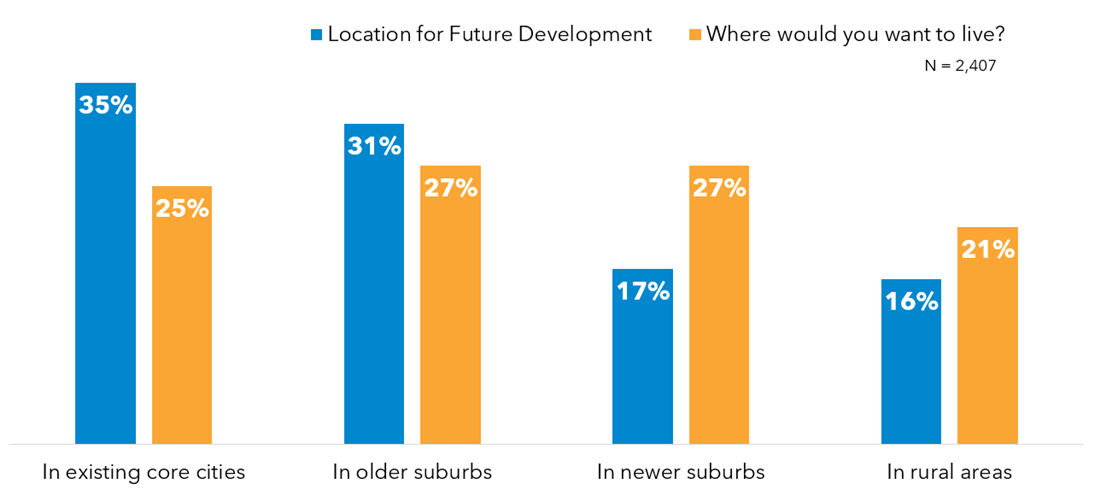
Improve Walking and Biking to Transit and Complete the National Capital Trail Network
Our region doesn’t have enough safe options for walking or bicycling to transit stations. Often, there are barriers in the way, such as a lack of safe sidewalk or crosswalks, or a major road that cannot be crossed. Building or repairing sidewalks, crosswalks, and constructing new trails would help people walk and bike safely and comfortably. First-and-last-mile connections would provide people with access to jobs and other destinations within a shorter commute time. And it would encourage more people to take transit to help reduce congestion for those who drive.
The National Capital Trail Network is a 1,400-mile, continuous network of long-distance, off-street trails, serving the entire region. Currently 1/3 complete, when it is completed, the network will provide healthy, low-stress access to open space and reliable transportation for people of all ages and abilities, and an environmentally friendly alternative to motorized travel. It will connect Metrorail Stations and the region’s Activity Centers, places where people can live, work, and play. When asked which improvements or changes would make them more likely to walk, bike, or use an e- powered or mobility device to the train station or bus stop, the most popular choice was “if there were sidewalks and safe crossings all the way there” (36%), followed by if “my route to the train or bus was quicker or more direct” (27%). These responses show that there is support to implement projects that would make walking and biking to transit safe, comfortable, and practical.
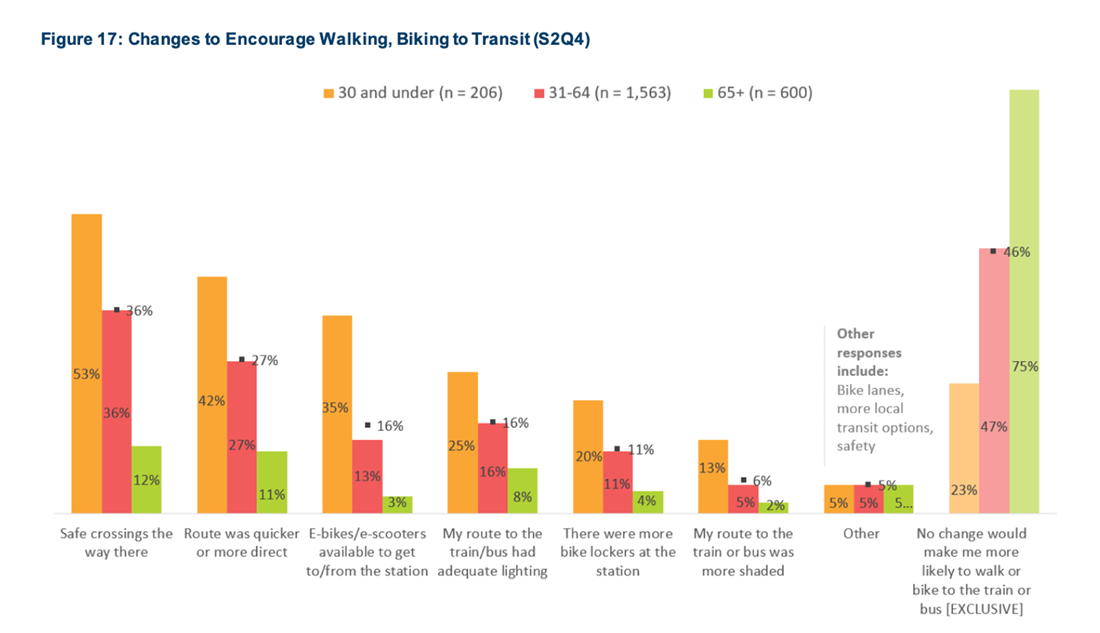
Expand Express Highway Network
The survey found that road congestion continues to impact residents of the region. When asked how big of a concern traffic congestion was to them personally, over two-thirds of respondents (69%) said that congestion was a concern that impacts the quality of their lives, with 44% saying it is a significant concern.
Adding toll lanes to existing highways throughout the region could help. Traffic on these lanes would be congestion-free because toll rates would increase during the most congested times of the day. This would result in reduced demand on traffic lanes, free-flowing traffic, and would encourage carpooling by exempting cars with more passengers from the tolls. The initiative also calls for a network of express buses that would travel in the express lanes toll lanes connecting people and jobs throughout the region.
This overwhelming concern for traffic congestion shows the importance of considering this initiative as transportation officials plan for the future.
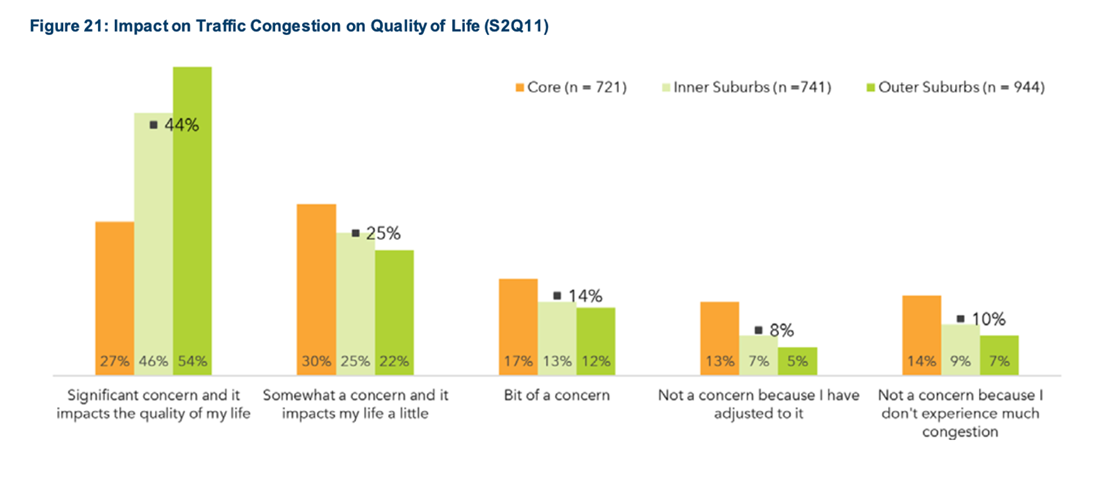
Simultaneously, this initiative acknowledges that not everyone will be able to regularly afford to drive in toll lanes and therefore, calls for these toll lanes to provide express bus services and exempts these buses from the tolls. Additionally, the initiative encourages ridesharing and exempts carpools and vanpools from tolls as well. Projects that implement this concept will address the mobility challenges that vulnerable populations face, such as essential workers who had to work during the pandemic. Survey responses from essential workers reveal that they are more likely to find the high price of tolls to be a barrier, with 23% indicating they "can't afford tolls to avoid traffic congestion," compared to 15% of non-essential workers.
Expand Bus Rapid Transit (BRT) and Transitways
This initiative promotes Bus Rapid Transit (BRT) throughout the region that would provide high-quality transit services that approach the speed of rail, but at a fraction of the cost to build. BRT buses would operate in their own separated lanes with pre-payment systems and level boarding to get people on and off quickly.
Respondents strongly support creating bus lanes to make bus trips faster. 71% support dedicated bus lanes to avoid congestion and make bus trips faster. When the survey specified that creating a bus-only travel lane would mean removing a lane of on-street parking, support went down but was still in the majority, with 54% respondents supporting this measure.
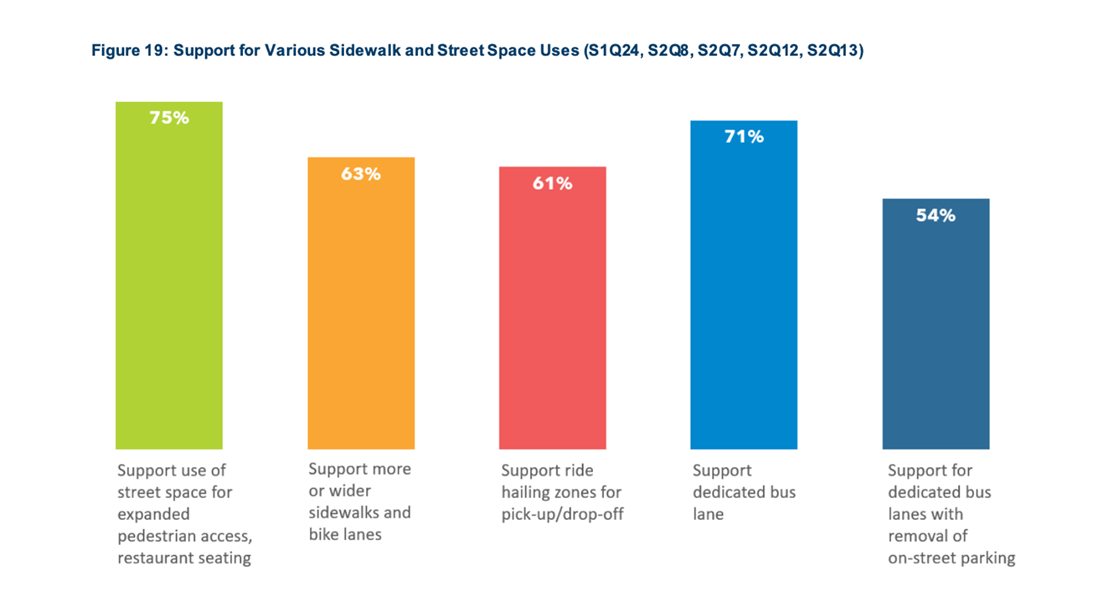
Another benefit that BRT services offer is faster bus service. On the survey, regular transit users were significantly more likely to say that the improvements they would like to see to their bus trips include “buses arriving on a reliable schedule,” (40%) followed by if “buses traveled more quickly “(26%), ultimately signifying strong support and the opportunity to implement more BRT service to address the concerns that bus users currently have.
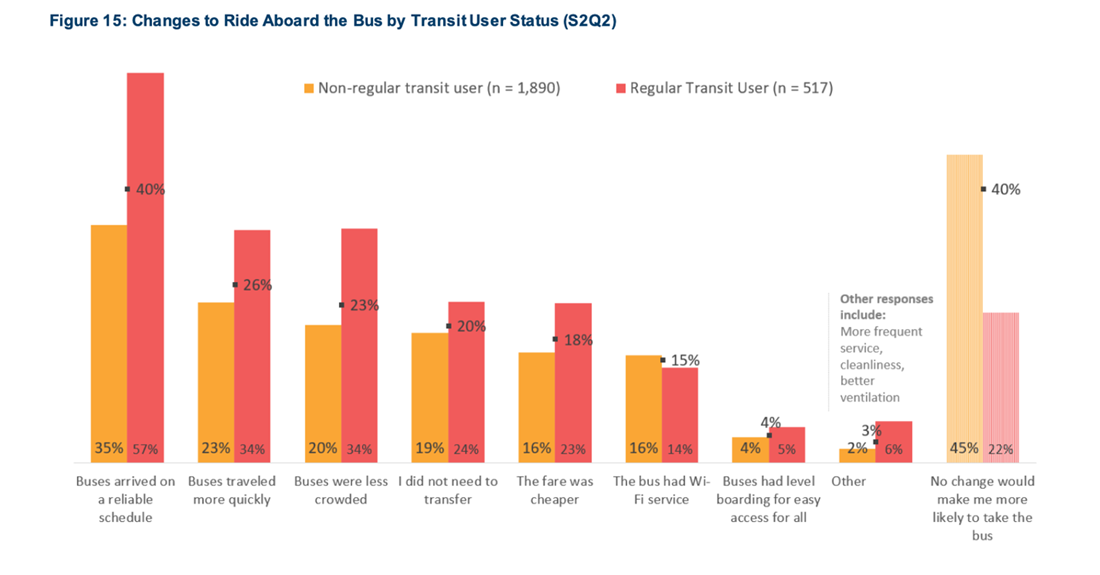
Provide More Telecommuting and Other Options for Commuting
This initiative would expand programs to increase the number of people who telework, find carpools, or use transit. These programs can be implemented by employers, government programs, or both. In addition, workplaces would let employees come to work early or late some days to avoid traveling during rush hour. The number of employees receiving transit and carpool subsidies from work would increase significantly. And workers who currently receive free parking could receive the cash value of that benefit to pay for transit or other commuting options (known as parking cash-out.)
The COVID-19 public health emergency forced many workers to work from home. This opportunity allowed workers to test out this work setting and understand the benefits that came out of working from home. The Voices of the Region survey shows that there is momentum to advocate for teleworking opportunities even after the end of the public health emergency. When examining the number of current telecommuters who want to continue telecommuting full time or for 3 or more days per week, we see that a majority of people currently teleworking would like to continue spending most of their time teleworking even after the pandemic. This shows that those who have tried teleworking during the pandemic want to continue doing so most of the time.
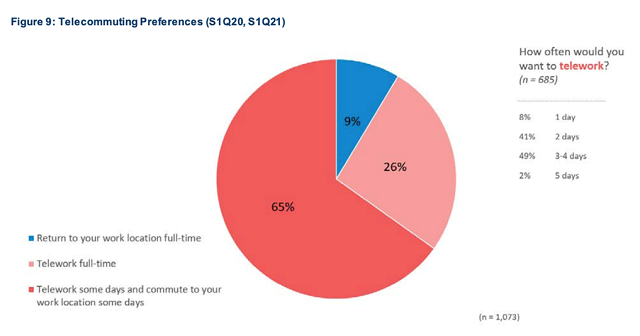
Read more: The Voices of the Region on travel during COVID-19
Move More People on Metrorail
This initiative advocates for moving more people through the center of the region on Metrorail. To move more people on Metrorail, there would be more trains and lines, and stations would be expanded. The focus would be on the downtown core of the region to accommodate more riders where stations and trains are overcrowded.
The significant number of the Voices of the Region respondents are worried about the frequency of trains and how crowded the trains can get during busy hours. When asked about possible improvements to rail transit, the most popular choice was for “trains [to come] more frequently” (chosen by 40%), followed by if “trains were less crowded” (35%).
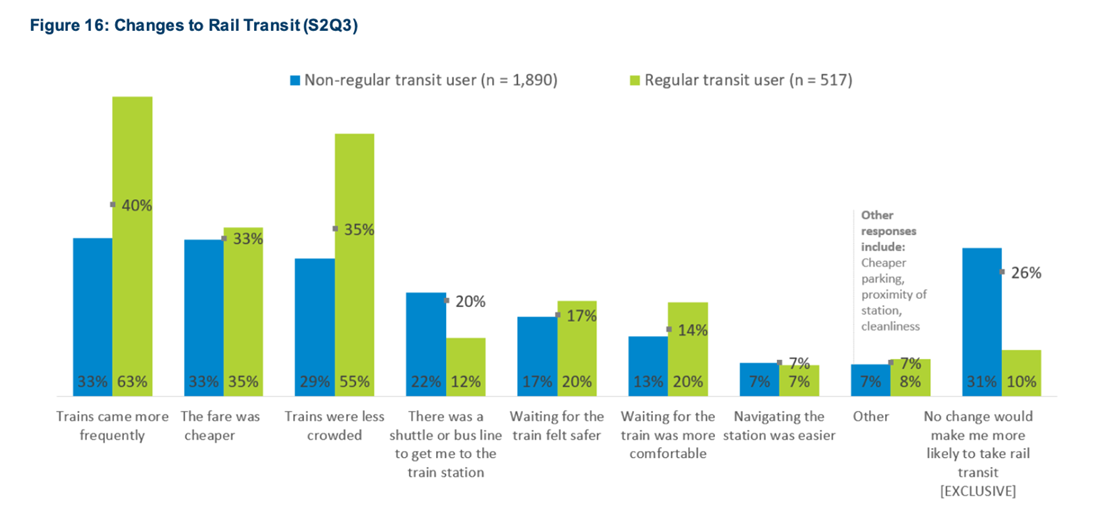
This initiative directly addresses the concerns of frequency and overcrowding that respondents reported on the survey. For example, the initiative encourages Metro to offer eight-car trains (instead of six-car trains) that run on all lines at all times to prevent over-crowding and to provide faster train service. It also encourages busy stations to be expanded to handle new riders with less crowding. These changes would include expanded mezzanines and new fare gates and escalators.
And while transportation officials can implement some of facility and operating changes to get more people on Metrorail, it is important to acknowledge that some people are not able to afford the transit fares. 33% of participants said that they would be more likely to ride transit if the fare was cheaper. Additionally, when asked to identify transportation barriers that they face, 11% of respondents reported that public transportation is too expensive for them.
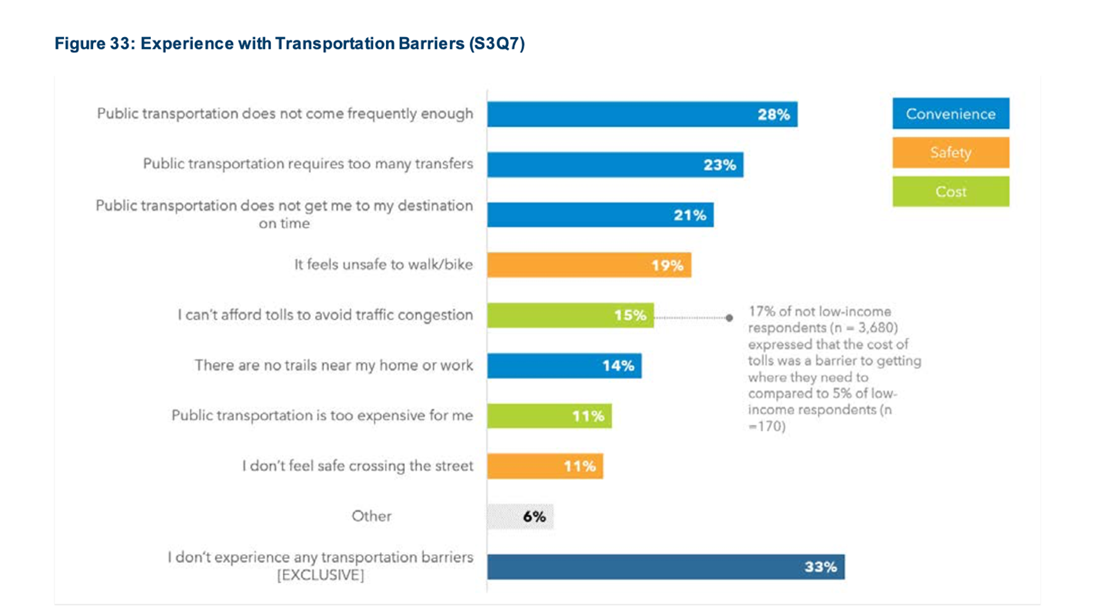
Now it’s your turn to examine these initiatives. TPB staff will launch its Aspirational to Implementation activity at the end of June. We will be highlighting examples of projects that align with the Aspirational Initiatives and have successfully been implemented throughout the region.
Join us on June 10 to learn more about how you can participate.
View the Voices of the Region survey report.